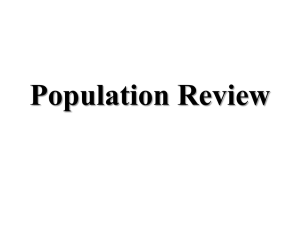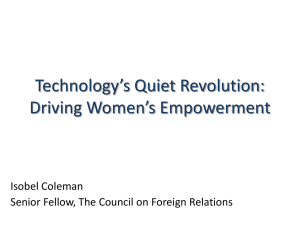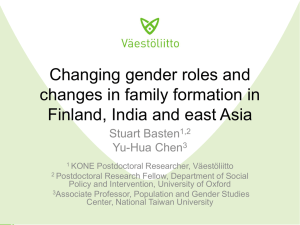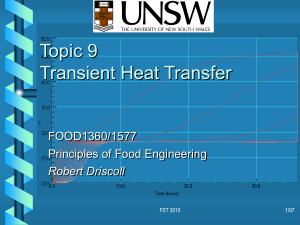Slides - Human Capital and Economic Opportunity Global Working
advertisement
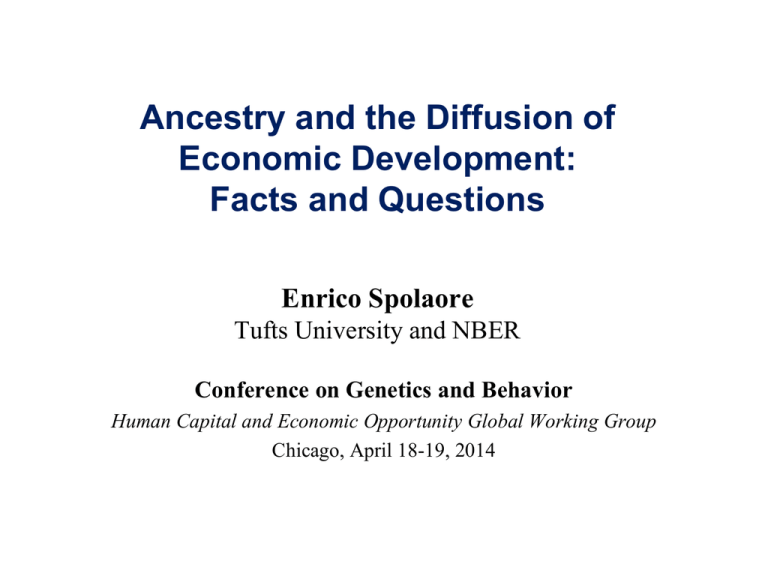
Ancestry and the Diffusion of Economic Development: Facts and Questions Enrico Spolaore Tufts University and NBER Conference on Genetics and Behavior Human Capital and Economic Opportunity Global Working Group Chicago, April 18-19, 2014 Summary • Facts: empirical relations between ancestral composition of current populations and aggregate socioeconomic outcomes (economic development, adoption of technological innovations) • Questions: Why does ancestry matter? Possible mechanisms • An example. The spread of the Industrial Revolution and the decline of marital fertility in Europe: a tale of two diffusions? References (joint with Romain Wacziarg, UCLA) • The Diffusion of Development, Quarterly Journal of Economics, May 2009 • How Deep Are the Roots of Economic Development? Journal of Economic Literature, June 2013 • Long-Term Barriers to Economic Development, in Handbook of Economic Growth, vol. 3, edited by P. Aghion and S. Durlauf, North Holland – Elsevier Long-term persistence holds at the level of populations rather than locations • A focus on populations rather than locations helps us understand both persistence and reversal of fortune, and sheds light on the spread of economic development. • Current economic development is correlated with historical characteristics of a population’s ancestors, including ancestors’ years of experience with agriculture, going back to the Neolithic transition. Table 6 from Spolaore and Wacziarg (JEL, 2013) Dependent variable: log per-capita income, 2005 Main regressor: Share of descendants of Europeans (1) Share of Europeans 1.058 (4.743)*** (2) (3) (4) (5) Sample Control for Control for Control for with less ancestryancestrygenetic than 30% of adjusted adjusted distance to Europeans years of state USA agriculture history weighted 2.892 (3.506)*** Ancestry-adjusted years of agriculture, in thousands Ancestry-adjusted state history Fst genetic distance to USA Weighted Constant Observations R-squared 1.079 (4.782)*** 0.105 (2.696)*** 1.108 (5.519)*** 0.863 (3.601)*** 1.089 (3.108)*** 8.064 (24.338)*** 150 0.526 -4.576 (2.341)** 7.853 7.676 7.195 8.637 (17.030)*** (21.984)*** (21.594)*** (20.941)*** 92 0.340 147 0.580 134 0.656 149 0.545 Why Does Ancestry Matter? Mechanisms • Intergenerational transmission can take place through different inheritance systems: biological, cultural, dual (gene-culture interaction) • The effects of inherited traits on productivity, fertility and other economic outcomes may be direct or operate as barriers to the transmission of innovations (new technologies, novel behaviors and values) A Taxonomy Mechanism of impact Type of transmission Direct Effect Biological (genetic or epigenetic) e.g. Galor-Moav (2002), Clark (2007) Cultural (behavioral or symbolic) e.g. Max Weber and many others (Bisin-Verdier, Tabellini, AlesinaGiuliano, ..) Dual (gene-culture interaction) e.g., Boyd and Richerson Barrier Effect e.g., Spolaore and Wacziarg (2009, 2012, 2013) Table 7 (JEL) – Genetic Distance and Economic Development, Cross-Sectional Regressions (dependent variable: log per capita income, 2005) Main regressor: (1) Indigenous genetic distance FST genetic distance to the USA, 1500 match FST genetic distance to the USA, weighted, current match Absolute latitude % land area in the tropics Landlocked -4.038 (3.846)*** dummy Island dummy Share of descendants of Europeans, per Putterman and Weil Constant Beta coefficients on the bold variable Observations R-squared (2) Ancestryadjusted genetic distance (3) Control for the share of Europeans 0.034 (5.068)*** -0.182 (0.582) -0.637 -6.440 (3.392)*** 0.030 (4.216)*** -0.041 (0.135) -0.537 -4.576 (2.341)** 0.015 (1.838)* -0.384 (1.189) -0.521 (3.686)*** (2.971)*** 0.584 (2.389)** 0.607 (2.392)** 8.451 (23.577)*** -23.85% 155 0.499 8.618 (21.563)*** -27.11% 154 0.496 (3.051)*** 0.557 (2.262)** 0.863 (3.601)*** 8.637 (20.941)*** -20.30% 149 0.545 The Diffusion of the Industrial Revolution (from Spolaore and Wacziarg, in Handbook of Economic Growth) The Diffusion of the Industrial Revolution A Key Behavioral Innovation: Reduced Marital Fertility • Fertility decline is not a new phenomenon historically, but in pre-modern times it tended to take place through marriage postponement and/or reduction of fertility outside marriage. • It is only in modern times that most people started to significantly reduce their overall fertility within marriage (e.g., studies in Coale and Cotts Watkins, 1986 – Princeton European Fertility Project). A Tale of Two Diffusions? Hypothesis 1: The spread of “modernity” involved two separate processes of diffusion -) The spread of technological innovations associated with the Industrial Revolution, where England played a leading role -) The spread of social/behavioral changes – such as marital fertility decline - where France played a leading role Hypothesis 2: The two diffusions followed different patterns, because societies at different relative “ancestral” distances from the innovators faced different barriers to imitation -) Societies that were relatively “closer” to England faced lower barriers to adopting the innovations associated with the Industrial Revolution (Spolaore and Wacziarg, 2009, 2012, 2013a, 2013b) -) Societies that were “closer” to France were more likely to adopt the social/behavioral changes pioneered by the French – such as lower marital fertility. Marital Fertility Decline in Europe Cross-national regressions for the transition date, focusing on genetic distance from France Univariate FST from France 0.163 (3.54)*** Geodesic Distance to France Absolute difference in latitudes, from France Absolute difference in longitudes, from France 1 for contiguity with France =1 if an island =1 if shares at least one sea or ocean with France Average elevation between countries to France Per capita income, 1820, from Maddison Constant # of nations 1,893.536 (426.44)*** 36 Control for distance Control for geography Control for initial income 1820 0.146 0.172 0.169 (2.78)*** (2.45)** (2.00)* 2.912 (0.64) 1.502 (0.11) -102.774 (0.90) 16.311 (0.61) -11.448 (1.11) 2.140 (0.13) 12.621 (1.19) -13.592 (0.49) -58.838 (0.39) 167.189 (0.63) -9.273 (0.59) 2.412 (0.08) 24.613 (1.39) 31.605 41.252 (1.26) (1.34) -0.001 1,891.221 (328.75)*** 36 1,881.119 (143.30)*** 36 (0.02) 1,865.035 (38.24)*** 26 Horserace France vs. England (Dependent variable: Fertility Transition date) Univariate FST from England 0.163 (1.77)* Control for distance 0.044 (0.30) FST from France Geodesic Distance from England Geodesic Distance from France Per capita income, 1820, from Maddison Constant # of countries 7.488 (1.01) 1,896.270 (323.18)*** 36 1,893.332 (289.02)*** 36 Horserace, simple Horserace, all geo. controls Horserace, all controls + income 1820 -0.131 (0.89) -0.236 (1.14) -0.344 (1.05) 0.177 (3.01)*** 0.225 (2.77)** 0.211 (1.87)* 18.444 (1.27) -10.546 (0.81) 94.460 (2.01)* -73.446 (1.53) 67.167 (0.77) -76.655 (1.13) -0.008 1,889.430 (311.11)*** 36 1,885.589 (82.78)*** 36 (0.14) 1,890.393 (15.86)*** 26 Linguistic Distance Linguistic Distance from Ethnologue (Gordon) number of different linguistic nodes between language A and language B Example: Linguistic Distance between Paris and Madrid Indo-European, Italic, Romance, Italo-Western, Western, Gallo-Iberian, Gallo-Romance, Gallo-Rhaetian, Français (Langue d’Oïl) Indo-European, Italic, Romance, Italo-Western, Western, Gallo-Iberian, Ibero-Romance, West Iberian, Castilian In Conclusion • Diffusion of fertility behavior and diffusion of economic development followed different patterns • The spread of lower marital fertility in Europe is consistent with diffusion from France, with societies closer to the French facing lower initial barriers to the adoption of the novel behavior, even through eventually all European populations adopted the new behavior • Barriers to diffusion seem to be in large part associated with differences in inter-generationally transmitted traits (relative genetic and ancestral linguistic distance) • Big open question: what specific mechanisms?


